Is there a case for Grace of Monaco as what George Orwell might have called a good bad movie ??
Jul 12th, 2015 | By L. Frank Bunting | Category: Countries of the World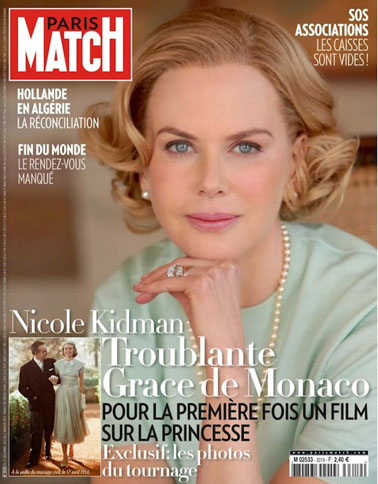 A few days ago my TV viewing partner and I caught up with the more or less new Grace of Monaco movie (aka Princess Grace on some listings), which in our part of the world apparently debuted on cable at the end of May this year.
A few days ago my TV viewing partner and I caught up with the more or less new Grace of Monaco movie (aka Princess Grace on some listings), which in our part of the world apparently debuted on cable at the end of May this year.
It’s directed by Olivier Dahan (from France) with a script by Arash Amel (from the UK and then the USA, by way of Iran!). And whatever else, it can boast such compelling actors as Derek Jacobi, Nicole Kidman, Frank Langella, Parker Posey, and Tim Roth.
At a certain point in Grace of Monaco many viewers will also decide that it is close to a totally crazy movie. For my TV partner and I the moment came when Ms Kidman, portraying Princess Grace, gave an altogether over-the-top speech to an alleged  roomful of French and other early 1960s critics of Monaco, at a meeting of the local Red Cross.
As the Wikipedia article on “Grace of Monaco (film)” makes clear, the movie has been more generally controversial at best : “Reviews of the film were overwhelmingly negative … Rotten Tomatoes … Â reports that 9% of 53 surveyed critics gave the film a positive review; the average rating was 3.3/10. The site’s consensus reads: ‘Beautifully shot but utterly vapid, Grace of Monaco fails to honor either its subject or its audience.’”
Having said all this, I must confess as well that my TV viewing partner and I finally watched Grace of Monaco through to the end. And when it was over we both agreed that, while it was totally crazy and certainly not a good movie in any ordinary sense, we had nonetheless enjoyed it.
A FEW MORE THINGS I KNOW NOW ABOUT ICE-COLD KELLY ON THE CÔTE D’AZUR
Strange what you remember as you get older. One strong Grace Kelly memory I have from my youth and/or late childhood involves reading an article about “Ice-Cold Kelly,” in one of my aunt’s movie magazines up at the cottage, on the fluted edge of the Canadian Shield.
Thanks to the marvels of the Internet, I have recently discovered that the article was in the September 1955 issue of  Modern Screen. I have also discovered various other related things :
1. Â Monaco then and now
The “Internet Movie Database (abbreviated IMDb)” summarizes Grace of Monaco as : “The story of former Hollywood star Grace Kelly’s crisis of marriage and identity, during a political dispute between Monaco’s Prince Rainier III and France’s Charles De Gaulle, and a looming French invasion of Monaco in the early 1960s.”
IMDb rates the movie as “5.6/10 from 9,489 users.” This is somewhat higher than the Rotten Tomatoes rating – and closer to my own feelings.
Similarly, the early 1960s dispute between Monaco and France did actually happen. It involved Grace Kelly’s husband Prince Rainier III, and the majestic and mysterious President Charles de Gaulle of France (played credibly enough in the movie by the French actor André Penvern).
Whatever else (again), Grace of Monaco at least brings this historical incident to a wider audience. Which includes me (and my TV viewing partner)! And btw, the current population of Monaco is “almost 36,000,” and that of France about 65 million. Monaco “is one of 5 European micro-States (the others being: Andorra, Liechtenstein, Malta, and the Vatican City).” And there are now “8,300 Monegasques” and residents from more than 120 other present-day nationalities in Monaco, “amongst them 300 Americans and more than 200 Canadians.”
2. Rainier’s long affair with Gisèle Pascal
Before his somewhat whirlwind courtship of the Hollywood actress Grace Kelly in 1955, Prince Rainier III of Monaco had an extended live-in affair with the French actress Gis̬le Pascal Рin the late 1940s and early 1950s.
The brief Wikipedia article on Ms Pascal seems to more or less summarize all this : “For six years she was involved in a relationship with Prince Rainier.” (A 2007 obituary in The Independent says “a well-documented 10-year liaison.” And the Wikipedia article on Prince Rainier himself reports that : “In the 1940s and 1950s, Rainier had a ten year relationship with the French film actress Gisèle Pascal.”)
For some time the couple “lived together in a villa in Saint-Jean-Cap-Ferrat” (on the Mediterranean Côte d’Azur a bit west of Monaco, near Nice). As Ms. Pascal’s Wikipedia article explains, however : “Princess Antoinette, Baroness of Massy, Rainier’s [older] sister, seeking to obtain the throne of Monaco for her own son, spread malicious rumors that Pascal was incapable of bearing children. A contemplated marriage was called off when a medical examination reported that she was infertile … Pascal subsequently married actor Raymond Pellegrin on 8 October 1955 and had a daughter, Pascale Pellegrin, on 12 September 1962.”
There are a few further wheels within wheels here. In 1953 Gisèle Pascal had a brief fling with the Hollywood actor Gary Cooper. In the same year Gary Cooper won an Academy Award for his performance in High Noon, opposite the 22-year-old Grace Kelly (as his young Quaker wife).
Then Gisèle Pascal married Raymond Pellegrin in October 1955. Only a few months later, Prince Rainier spent the Christmas holidays with Grace Kelly’s parents in the Philadelphia metropolitan area of the Delaware Valley. Once all the medical examinations and financial arrangements had been satisfactorily completed, he proposed marriage to their daughter.
Ice-Cold Kelly accepted. And the rest is the history that the movie Grace of Monaco tries to bring to life.
3. The Matchmaker : Rev. John Francis Tucker, “first American born Oblate and chaplain to Prince Rainier (Monaco).”
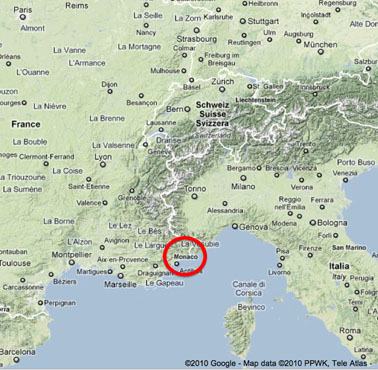
Monaco in its wider European setting, surrounded by France, just west of Italy, and south of Switzerland.
In response to various criticisms, both the director and script writer of Grace of Monaco have urged that, like other creators of what might be called historical fiction movies, they have not tried to make an exact documentary.
As noted above, the current Prince Albert II and his two sisters would second that motion. (As would  Alex von Tunzelmann in theguardian last year. See his “Grace of Monaco – historically accurate? You’ve got some de Gaulle.”)
Olivier Dahan (director) and Arash Amel (writer) have nonetheless at least acquainted us with the main real-world historical characters in what is, at its best at any rate, the kind of slight story  at the margins that still casts light on deeper and wider themes.
One case in point is the Rev. John Francis Tucker, portrayed by Frank Langella in the movie.  There appears to be a long European history of Catholic clerics as policy advisors to the “house of Grimaldi,” that “has ruled over Monaco since 1297.” But Prince Rainier Grimaldi III may have been  especially lucky that his clerical advisor was an American priest from the Philadelphia metropolitan area (aka the Delaware Valley, Eastern USA).
Put another way, was the contemplated marriage to Gisèle Pascal really cast aside because of Rainier’s older sister’s intrigues? Or had Father Tucker finally convinced the prince on the benefits of an American wife for the future of the Monaco micro-State (surrounded by France), in the new American free world order after the Second World War? (And/Or did Rainier conclude that if he couldn’t have Gisèle Pascal, he might as well have a wife who could do what would nowadays be called the Monaco brand some good?)
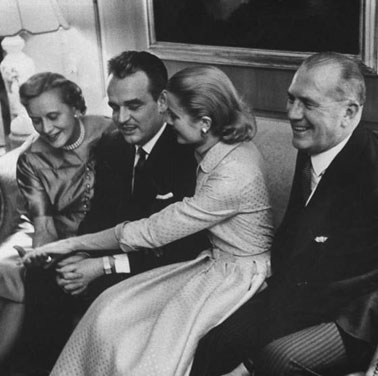
Grace Kelly and Prince Rainier show her engagement ring to her mother and father at the Kelly home in Philadelphia, 1956. Howard Sochurek–The LIFE Picture Collection/Getty Images. On some accounts it was actually Father Tucker who made the proposal of marriage to Grace Kelly’s father!
Whatever the most exact and deepest truths may be, even in the somewhat more objective historical record that can be sampled on the net one thing seems clear enough. The Rev. Tucker from the Philadelphia area played some kind of matchmaking role in the ultimate marriage of Prince Rainier of Monaco and the American actress (and “Philadelphia debutante”), Grace Kelly.
As explained by a 1996 article in People magazine, Kelly met Rainier during the Cannes Film Festival in the spring of 1955. Then : “After returning to the States, she and the Prince began a correspondence that was avidly pushed along by Father Francis Tucker, the American priest who was Rainier’s closest aide and chief talent scout for eligible Catholic girls.”
Once Rainier and Kelly had become better acquainted through their written correspondence, Father Tucker wrote to the young actress (still just in her mid 20s) : “I want to thank you for showing the prince what an American Catholic girl can be and for the very deep impression this has left on him.”
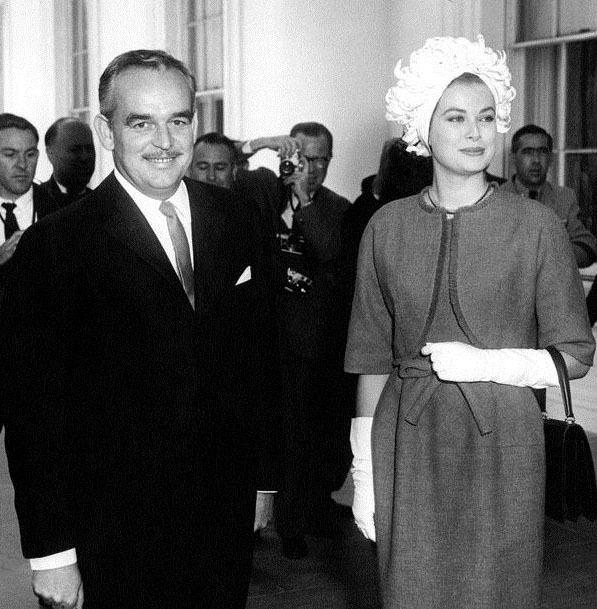
Prince Rainier III and Princess Grace arrive at the JFK White House in Washington for a luncheon, 24 May 1961.
According to Grace of Monaco, Father Tucker would also become an important advisor and confidant for the new Princess Grace, after her April 1956 marriage to Prince Rainer III, in what the American (and other) media called the “Wedding of the Century.” And this too seems confirmed by the more objective historical record.
According to Grace of Monaco as well, having an Academy Award winning, A-list American actress and Hollywood celebrity as the Prince’s wife certainly did help Rainier’s Monaco successfully navigate its early 1960s conflict with Charles de Gaulle’s new Fifth French Republic. At one apparently not even inexactly historically accurate point in the movie, someone who looks a lot like John F. Kennedy’s defense secretary Robert McNamara says to President de Gaulle, “You’re not really going to drop a bomb on Princess Grace, are you, Charles?”
4. But why did Grace Kelly do it .. and did she come to regret her decision in the end?
Having now waded through more than a few relevant items on the net (beyond the movie itself), I think one of the more fundamental historical-accuracy problems with Grace of Monaco is that it does almost fantastically overestimate the role of Princess Grace in engineering and ensuring Monaco’s 20th century political (and economic) survival.
And, as a corollary, it almost fantastically underestimates the role of Prince Rainier – Â a sin that Tim Roth is unhappily assigned to bring to troubled human life in the movie.
At the same time, the American Catholic intrigues of Father Tucker do clarify a very rational case for a 32 year-old Catholic Prince Rainier to welcome the prospect of marrying an attractive and popular young American actress from a wealthy American Catholic family – just four years before the election of the first Catholic president of the USA. (And by a [now somewhat revised] 1918 agreement, if the ruling prince has no legitimate heir at all, the sovereign principality of Monaco will finally become part of France.)
The biggest question about Princess Grace, on the other hand, is just why did she do it? What was in it for her? (Especially when you think she had to pass an intrusive medical exam, to prove she could have an heir to the princely throne – and then someone apparently had to pay a $2 million dowry to the Grimaldi family!)
At the still quite young age of 26 Grace Kelly had rather suddenly become a big Hollywood star. Just before she met Rainier at Cannes in 1955, she had won the 1954 Best Actress Oscar for her role in The Country Girl. Almost every man who ever worked with her seems to have fallen in love with her. In the middle of the 1950s she could look forward to a big career in an emerging new entertainment capital of an emerging new American-dominated global village.
Why did she want to become the wife of an obscure European aristocrat called the Prince of Monaco? (Which some of her Philadelphia relatives kept confusing with Morocco!)
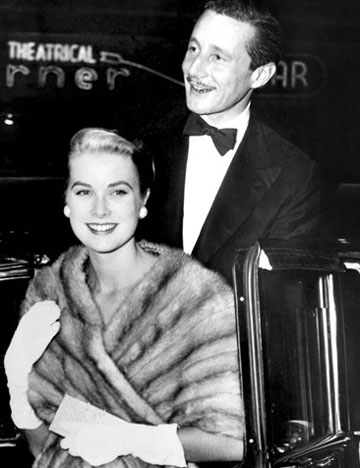
Grace Kelly and fashion designer Oleg Cassini on the town in the mid 1950s. He wanted to marry her and she at first agreed. But her parents talked her out of it. A bit like Rainier and Giselle Pascal!
To start with, somewhat like Prince Rainier III with Gisèle Pascal, the young Grace Kelly had  her own earlier contemplated marriage, to the French-born American fashion designer Oleg Cassinni.  Her parents persuaded her to abandon the engagement. (Among other things, Cassinni was 16 years older and had already been married, twice.) On the rebound from all this “my prince” Rainier does seem to have struck Ice-Cold Kelly in a few vulnerable places.
Yet setting all such immediate emotional logic aside, insofar as there is a rational answer to the question of why Grace Kelly would actually want to marry Prince Rainier III, I think it  has to have something to do with Monaco (which I can understand myself, in part anyway), and/or with the notion of becoming a real-world princess (which just seems too crazy to me).
In fact, there are some interesting things about Monaco, even today. They start with its location on the Côte d’Azur or French Riviera, on the sparkling Mediterranean Sea – a geographically and in other ways intoxicating playground for the rich and famous of the western world since the 19th century. Then even if you are resolutely anti-royalist and republican (as are both my TV viewing partner and I, especially for the future of Canada where we live ourselves), there is at least an interesting political point about Monaco today as well.
It is a rare survival of much older forms of European political organization, now vanished in most other places. More exactly, it is a geographically quite small feudal estate (“only 1.95 square kilometers [0.75 square miles] in area, or about 3 times the size of the Mall in Washington, DC”) with 13th century medieval origins. But it has retained a surprising degree of political sovereignty into the 21st century. (Though Monaco is defended militarily by France, and its continued sovereign independence does ultimately depend on French goodwill.)
The ruling Grimaldi family’s unique traditions and culture must have something to do with Monaco’s strange survival as a viable micro State in Europe even today. And the great focal point of these traditions since the middle of the 19th century has been the growth and development of the world-class Monte Carlo gambling casino.
In the 20th century (and beyond) this worldly innovation made the Grimadlis wealthier than most old European aristocratic families. The relevant Wikipedia article points out that “the Monte Carlo Casino is a gambling and entertainment complex located in Monaco.” It is “owned and operated by the Société des bains de mer de Monaco, a public company in which the Monaco government and the ruling family have a majority interest. The company also owns the principal hotels, sports clubs, food service establishments, and nightclubs throughout Monaco.”
(And on the post Second World War talents of Grace Kelly’s husband in this connection, note as well that, according to Wikipedia : “Aristotle Onassis had a controlling stake in the Casino de Monte Carlo in the 1950s until he was forced out by Rainier III, Prince of Monaco.”)
5. The good Princess Grace testimony of Anthony Burgess who lived in Monaco … Â (and how this may be further borne out by the career of her son, Prince Albert II, the ruler of Monaco today)
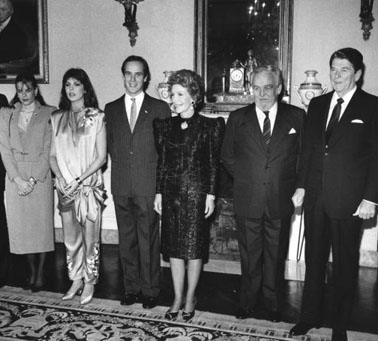
President and Mrs. Reagan with Prince Rainier and his family without Princess Grace, February 1984. The “royal family members stayed at the White House when they visited Washington to attend a series of fundraisers for the Princess Grace Foundation.”
I am getting to the point where I really must rush to finish all this already far too long Monegasque meandering – for the relief and benefit of any readers who may still be reading!
So … Â the argument that Grace Kelly wanted to marry Prince Rainier because she valued the unique historical interest in the long struggle of the Grimaldi family to keep their sovereign feudal estate alive and well in the modern age implies a quite worldly, Â intellectually sophisticated, and/or cynical (even Nietzschean?) young American actress.
But was Grace Kelly, born to an affluent and accomplished (and Catholic) Philadelphia family, just after the great New York stock market crash of 1929, really such a person?
It is ultimately a virtue of Grace of Monaco, I think, that it raises or opens up this question. But it is also a clear flaw or failure of the movie (or worse) that it tries to answer the question in an, at best, Â sophomoric and altogether unconvincing way.
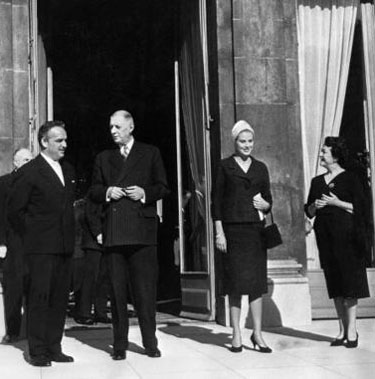
The Grimaldis and the de Gaulles chat outside some official function. Always nice on the French Riviera.
The essential problem was caricatured neatly (and with impressive nastiness) by Alex von Tunzelmann in his attack on Grace of Monaco’s historical accuracy, in theguardian last year.
In the movie, von Tunzelmann wrote, “Rainier faces a challenge to his rather diminutive power: Charles de Gaulle. The French president intends to blockade Monaco to force it to pay French taxes. There was such a crisis in 1962, but, in order to create sympathy for Grace and Rainier, the film needs you to see it as a proud Monegasque struggle for freedom and democracy. The problem is, what it was really about was the presumed right of the super-rich to sequester their obscene wealth in a ridiculous Ruritanian principality.”
(Ie, Monaco in the 1960s, thanks to the cunning rule of Prince Rainier and the Grimaldi family some would say, was increasingly both a traditional gambling casino, and a prescient new tax haven and luxury tourist trap, ready to rake in the takings of the rising new global village.)
From this angle, some friends and acquaintances apparently say, Grace Kelly was at any rate not cynical and worldly enough to  appreciate let alone seriously enjoy all these adventures in the real worlds of politics and economics.
Her deepest motivation for wanting to marry into the to the “house of Grimaldi” that “has ruled over Monaco since 1297” finally did lean too much on every young Philadelphia debutante’s dream of becoming a real-world princess, somewhere with a palace across the sea. And she was of course bound to be disappointed in the end. Fairy tales never really come true, Frank Sinatra notwithstanding.
Alex von Tunzelmann caricatures this view of the story rather neatly as well : “‘I love you,’ whispers Rainier to Grace as she sits down. Presumably, this is supposed to signify a happy ending. In fact, the marriage was not a success. Grace and Rainier continued to spend a great deal of time apart, and she eventually moved alone into an apartment in Paris. In later life, she told friends she no longer dreamed of being a princess: instead, she fantasised about becoming a bag lady. Now, that might be a fairytale worth telling.”
This is a popular enough point of view. (See also, eg : “Lonely and desperate, how Grace Kelly tried to escape her cruel sham of a fairytale marriage.”) And I was starting to find it almost compelling myself, until I remembered a book review by the author and writer extraordinaire  Anthony Burgess (probably most famous for his troubling 1962 novella A Clockwork Orange, made into a 1971 hit movie by Stanley Kubrick).
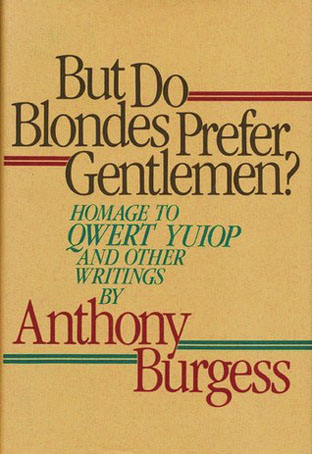 Burgess, who I confess to liking quite a lot myself, especially in short doses like book reviews, lived in and worked out of Monaco for some time, and actually knew Grace Kelly. Before her “damnable” 1982 death in a car accident “on one of the most dangerous roads in Europe,” at the age of 52, there were even plans for Anthony Burgess to work with the former American actress on a particular cultural project.
Burgess, who I confess to liking quite a lot myself, especially in short doses like book reviews, lived in and worked out of Monaco for some time, and actually knew Grace Kelly. Before her “damnable” 1982 death in a car accident “on one of the most dangerous roads in Europe,” at the age of 52, there were even plans for Anthony Burgess to work with the former American actress on a particular cultural project.
As he explains : “Princess Grace was to preside over a kind of free open university in which I, and one or two others who cultivate the arts more than the bars, were to participate.” In the middle of the 1980s Burgess published a review of Sarah Bradford’s early short biography, Princess Grace. And this review was republished in a collection of his shorter writings called But Do Blondes Prefer Gentlemen?, which I still have on my shelves.
Anthony Burgess’s friendship with Princess Grace Kelly Grimaldi of Monaco is bound to colour as well as instruct his feelings about her. As he wrote about the princess in his review of Ms Bradford’s 1984 book : “A year and a half after her death she is terribly missed. She was beautiful and elegant but, above all, good.”
Burgess notes as well that the marriage of Grace Kelly and Rainier Grimaldi “was an intriguing situation and the press, vulgar, lying, intrusive, insolent, drank deep of it. Having seen Grace married, it wanted the scandal of her unmarrying. But Grace stayed married, and happily, and she saved the principality from French appropriation by securing the dynastic line.”
Burgess also explains how Charles de Gaulle was irked “when he saw Monaco welcoming French commerce to its tax-free shores.” (Well, not entirely tax free, it seems, but … And, as already alluded to, one of Prince Rainier’s key economic development goals was to boost the Monte Carlo Casino’s strictly gambling revenues by promoting “Monaco as a tax haven, commercial center, real-estate development opportunity, and international tourist attraction.”)
Burgess stressed that “Rainier is a tough and resourceful monarch as well as a skilled diplomat. Grace, being a sort of goddess – a higher rank than princess – did her share in securing a place in the sun for the famille princière. Monaco and its monarch were taken seriously at last …”
Prince Rainier III Â passed away in 2005 at the age of 81, some 23 years after his wife’s death. He never remarried, and seems to have left a substantial financial legacy, in several respects. He was succeeded by his son, Prince Albert II (who received his higher education at Amherst College in Massachusetts, as his mother no doubt wanted). And after some teething problems (and more than one acknowledged “illegitimate” child born out of wedlock!), by the summer of 2015 it seems arguable enough that Prince Albert is growing into the job, in the somewhat more democratic constitutional monarchy that is another of his hardworking father’s legacies.
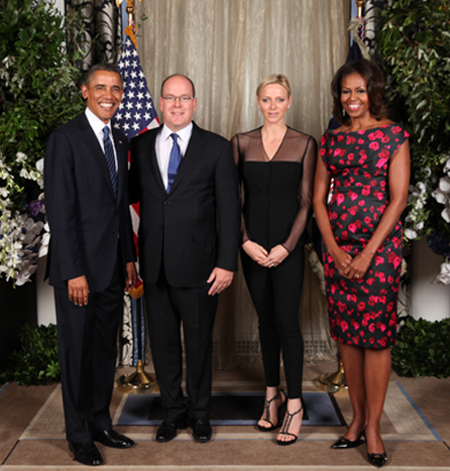
Prince Albert and Princess Charlene of Monaco, with President and Michelle Obama, at the Waldorf Astoria Hotel in New York, September 2013.
In 2011 Albert II properly married the former South African swimmer Charlene Wittstock at Monaco’s “biggest party in 55 years.” And on December 10, 2014 Princess Charlene gave birth to  twins –  Gabriella Thérèse Marie, Countess of Carladès, and Jacques Honoré Rainier, Hereditary Prince of Monaco. The line, that is to say, has been secured again. And if you have any kind of grudging admiration for the tough and resourceful skilled diplomacy that the Grimaldi family has somehow managed to demonstrate for a very long time now, and over many generations, you have to at least smile. It cannot be an easy trick, as the few survivors attest.
It also seems a reasonable enough guess, I finally think myself (fan of Anthony Burgess as I am), that somewhere the ghost of Grace Kelly Grimadli, princess and goddess of Monaco, and formerly star of stage, screen, and earlier TV in the United States of America, is smiling too.
6. Â If it’s not quite as bad as some have claimed, does Grace of Monaco also qualify as some kind of Orwellian good bad movie?
The short answer is no … unfortunately. (And for Orwell’s concept of “good bad poetry” see his 1942 review of T.S. Eliot’s selection of Rudyard Kipling’s “verse.”) But, like my TV viewing partner and I, you just might enjoy the movie anyway.
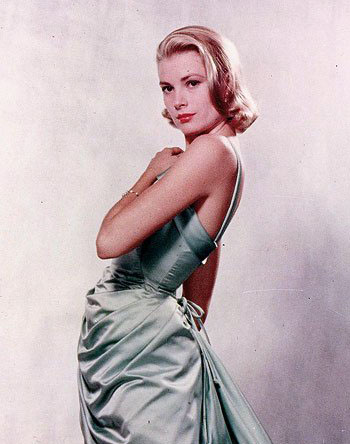
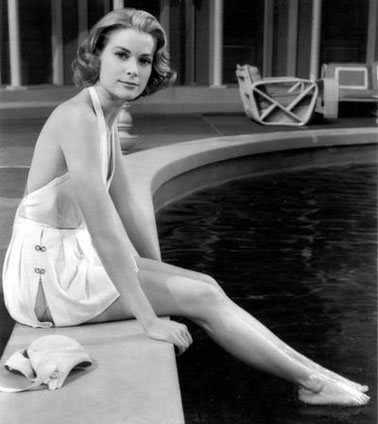
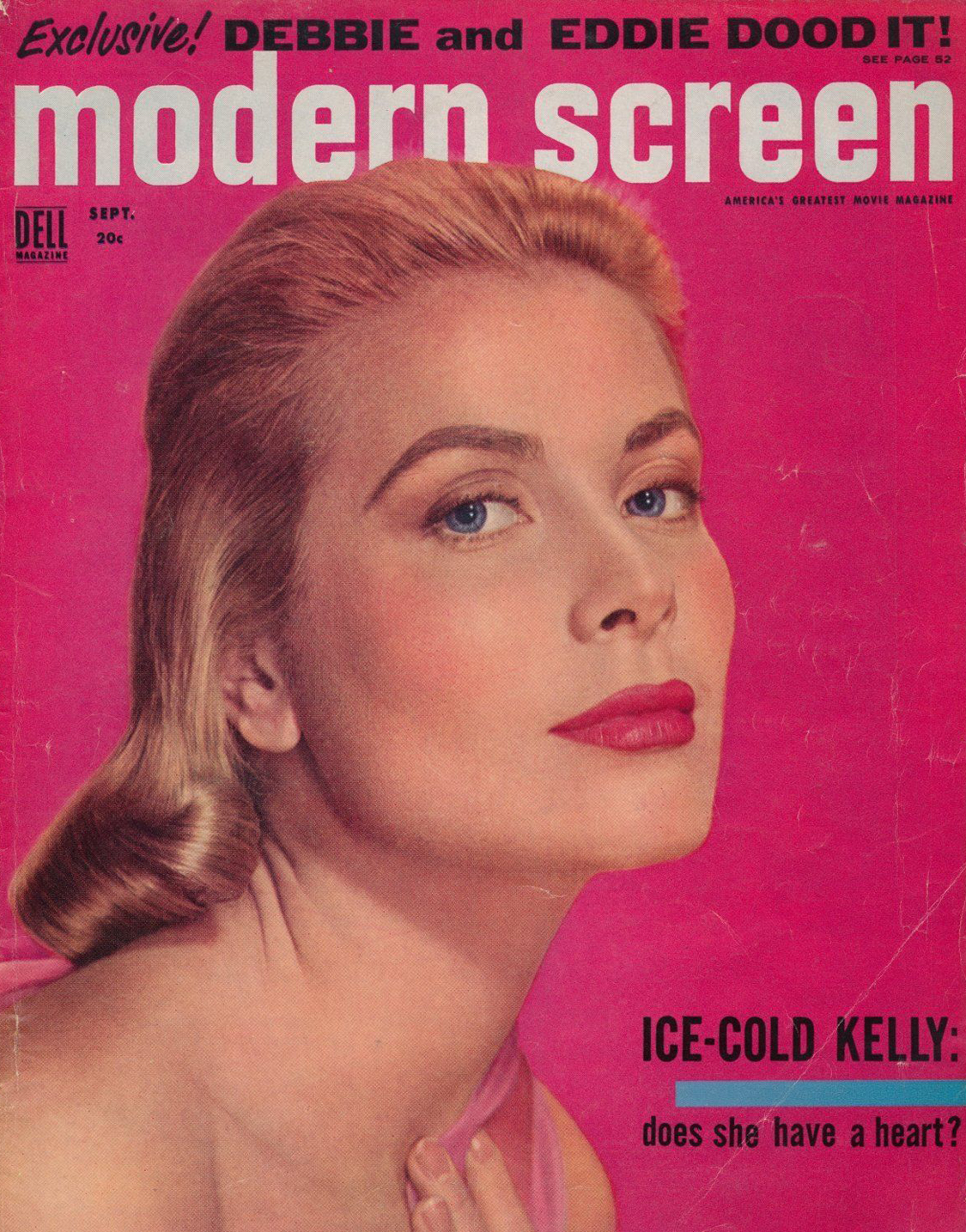
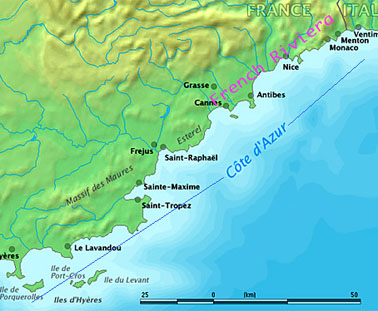
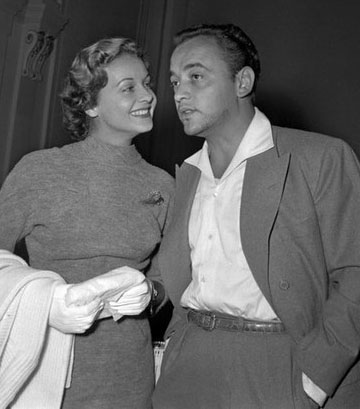
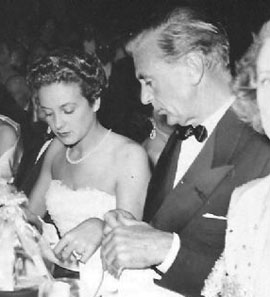
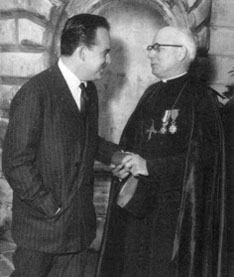
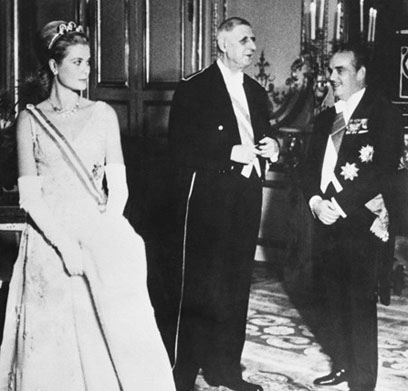
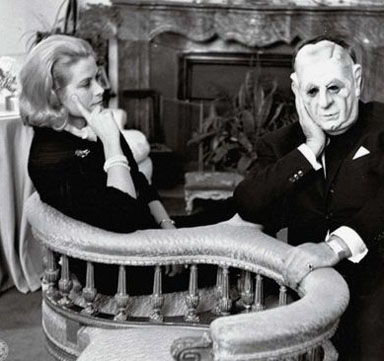
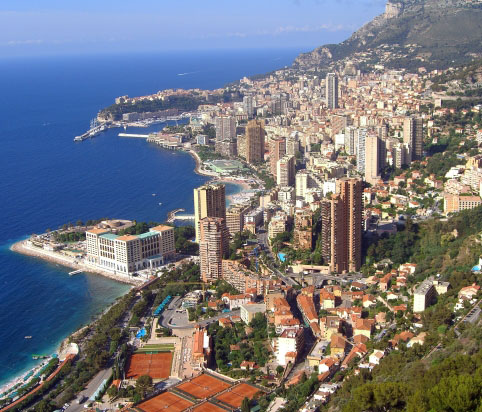
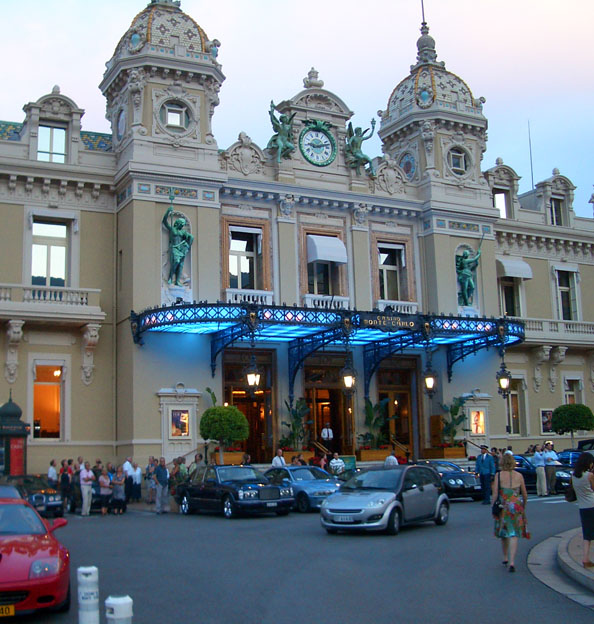
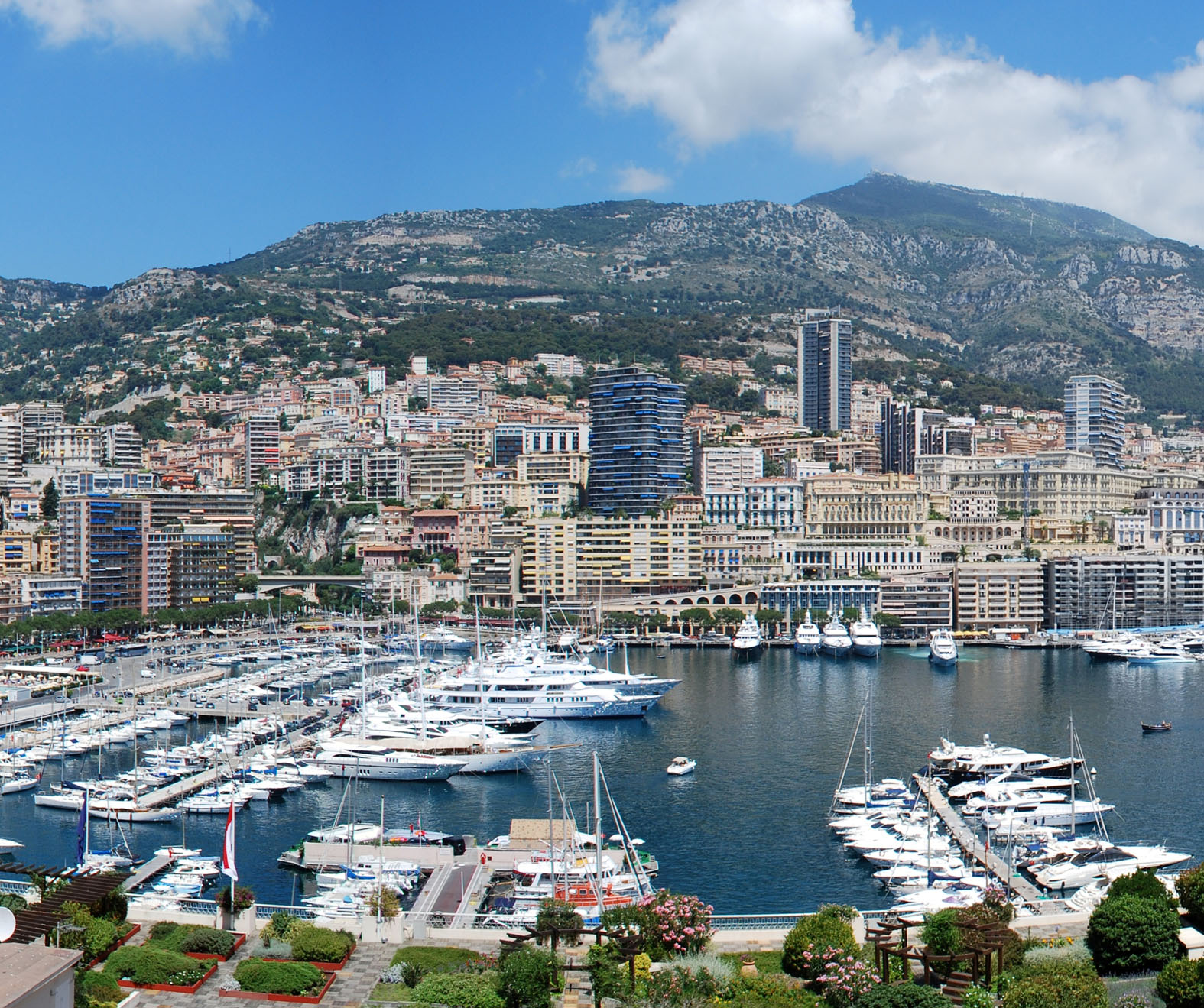
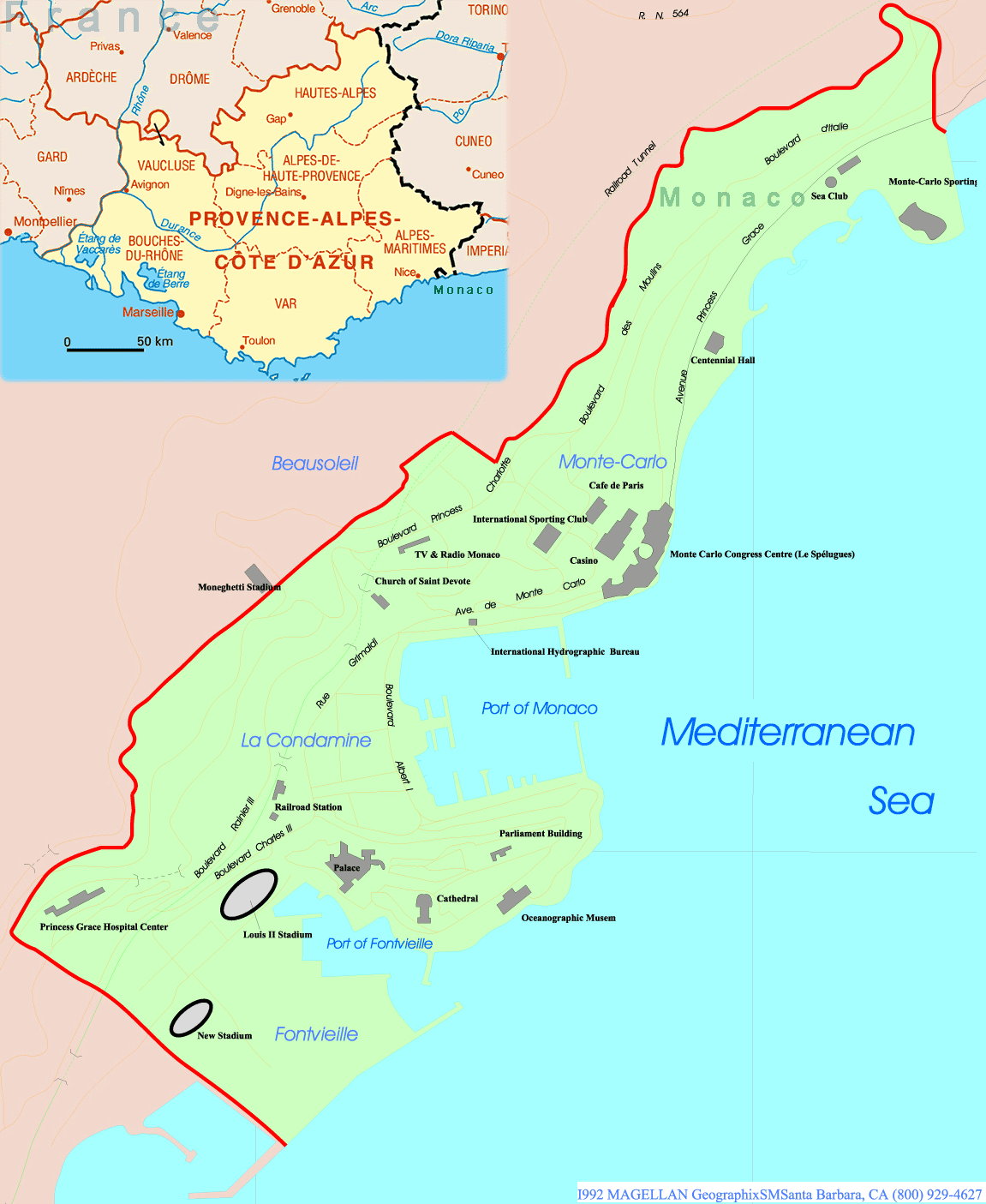



[…] Download ImageMore @ http://www.counterweights.ca […]